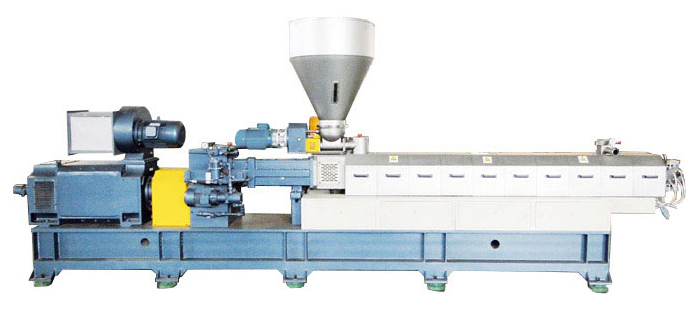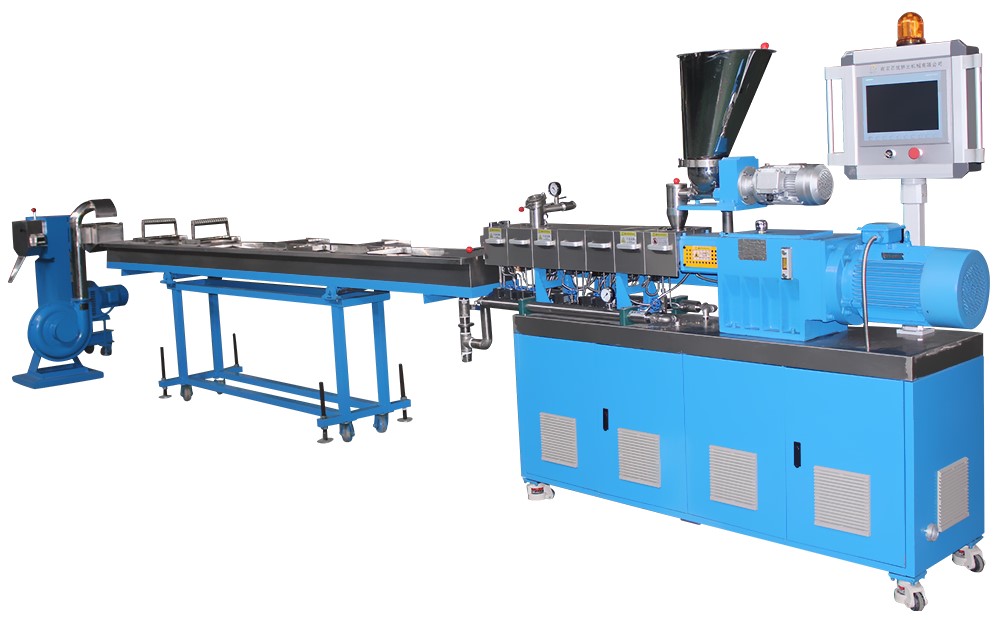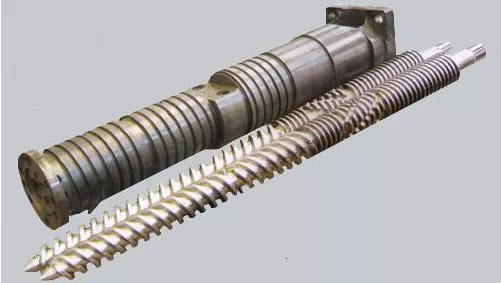Is a parallel twin screw extruder better or a conical twin screw extruder? This is a question often asked by customers when purchasing a twin screw extruder.
Classification of Twin Screw Extruders
According to the rotation direction of the twin screw, the extruder can be divided into two kinds of extruders, the same direction and the different direction. A co-rotating extruder means that the two screws work in the same direction of rotation, while a non-rotating extruder means that the two screws work in opposite directions.
According to whether the axis of the twin screw is parallel or not, it can be divided into two types of extruders, the axis of which is parallel and the axis of which intersects. A parallel twin-screw extruder whose axis is parallel, and a conical twin-screw extruder whose axis intersects.

Parallel twin screw extruder

Conical twin screw extruder
The Similarities And Differences Between Parallel And Conical Twin Screw Extruders
The Parallel Twin Screw Extruder
Due to the small size of the center distance between the two screws, in the transmission gearbox, the space for the radial bearings and thrust bearings supporting the two output shafts and the related transmission gears is very limited. Although the Chuangbo designers tried their best, they couldn't solve the reality of bearing load capacity, gear module, small diameter, and small diameter of the tails of the two screws, resulting in poor torsion resistance.
The small output torque and poor load resistance are the most significant defects of the parallel twin-screw extruder. However, the plasticity of the length-to-diameter ratio is the advantage of the parallel twin screw. It can increase or decrease the length-to-diameter ratio according to the difference in molding conditions to meet the requirements of plastic processing technology. Parallel twin screw extruder can expand the applicable range of parallel twin screw, which is difficult for conical twin screw extruder.
The parallel twin-screw extruder has a conveying mechanism that forces the plastic forward, has good mixing plasticization capacity and devolatilization capacity, and has basically the same adaptability to the material and plastic product molding process.

The Conical Twin Screw Extruder
The two conical screws are arranged horizontally, and the two axes are installed into the barrel at an included angle. The center distance of the two axes gradually increases from the small end to the large end, so that the two output shafts of the transmission gearbox have a larger center distance.
The gears and gear shafts in these transmission systems, as well as the radial bearings and thrust bearings supporting these gear shafts, leave a large installation space, which can be equipped with larger specifications of radial bearings and thrust bearings. Each driveshaft has a shaft diameter sufficient to meet the transmission torque, so large working torque and large load-bearing capacity are a major feature of the conical twin-screw extruder. This parallel twin-screw extruder is incomparable.

Concentric Distance
The center distance of the flat twin screw is the same, the two axes of the conical twin screw are at an angle, and the size of the center distance changes along the axis.
Diameter
The diameter of the parallel twin screws is the same, and the diameter of the small end of the conical twin screw is different from the diameter of the large end.
Aspect Ratio
Parallel double screw (L/D) refers to the ratio of the effective part length of the screw to the outer circle of the screw. Conical twin screw (L/D) refers to the ratio of the effective part length of the screw to the average of the diameter of the large end and the diameter of the small end.
From the above, we can clearly see that the most significant difference between parallel and conical twin-screw extruders is the geometrical shape of the screw and barrel, which leads to many differences in structure and performance. Although the characteristics of the two are different, they have their own advantages.
Non-return Bearing of Twin Screw Extruder
When the twin-screw extruder is working, the melt will generate very large pressure (head pressure) at the screw head. The pressure is usually around 14MPA, and sometimes even as high as 30MPA. This pressure forms a strong axial thrust on the screw, and resisting the thrust is the function of the anti-return bearing.
The conical twin-screw extruder has an included angle due to the arrangement of the two screws, so the two output shafts of the transmission gearbox have a larger center distance. The gear box is equipped with two large thrust self-aligning ball bearings staggered back and forth, which is sufficient to prevent the axial force formed by the head pressure. It is characterized by large carrying capacity, the low manufacturing cost of the gearbox, and convenient maintenance.
Conclusion
For customers, the purchase of twin-screw extruders is very important. Different types of twin-screw extruders have different properties and applications. Therefore, it is necessary to clarify the performance and application of various twin-screw extruders.
For example, the intermeshing co-rotating twin-screw extruder is a combined screw due to its high speed and high shear rate. It is widely used in the modification of polymers that are not easily decomposed by heat-compounding, filling, fiber reinforcement and reactive extrusion of materials.
For example, the intermeshing counter-rotating twin-screw extruder, because of its good mixing and plasticizing function, its biggest feature is the direct molding of PVC powder. If the geometric structure of the screw is changed, it can also be used for the forming and processing of other materials, but its strength is still the forming and processing of PVC.
According to the size of the plastic section, determine the extrusion volume, and then select the specifications of the twin-screw extruder by the extrusion volume. Under the condition that the plastic processing and molding process conditions are basically the same, the conical twin-screw extruder can adapt to the larger head pressure, and the parallel twin-screw extruder can adapt to the smaller head pressure.






